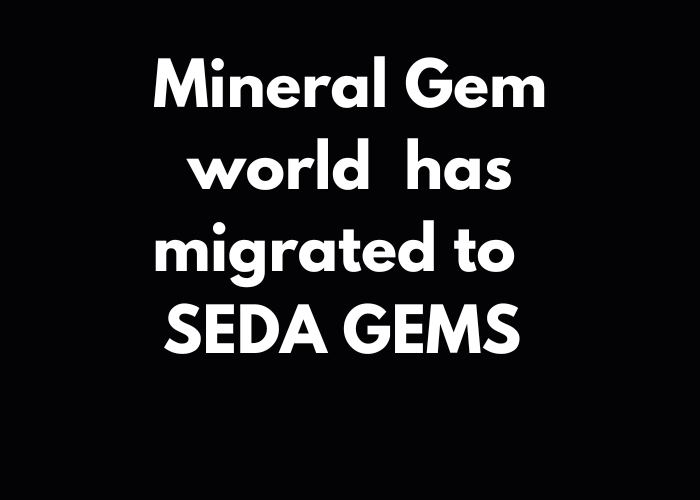Non hai fatto offerte per questa asta.
26.30 CTS AMMONITE INDONESIAN -WELL POLISHED [MGW4080]3
- SKU
- Dimensioni (mm)
- 20.000 x 18.000 x 11.000mm
- Peso (cts)
- 26.300
- Treatment
- No Treatment
- Tipo
- Bead
- Colori
-
MINERAL GEM WORLD
INDONESIAN AMMONITE
This is a colourful natural untreated specimen of ammonite from Indonesia.
They can be kept as a specimen or drilled and made into colourful pendants.
Well polished
Weight 26.30 cts app
Size 20 x 18 x 11 mm app
Ammonites, as they pertain specifically to the order Ammonitida, are an extinct group of marine animals belonging to the cephalopod subclass Ammonoidea. They are excellent index fossils, and it is often possible to link the rock layer in which they are found to specific geological time periods.
The closest living relative of the Ammonitida, is not the modern Nautilus which they somewhat outwardly resemble, but rather the subclass Coleoidea (octopus, squid, and cuttlefish).
Their fossil shells usually take the form of planispirals, although there were some helically-spiraled and non-spiraled forms (known as “heteromorphs”). Their name came from their spiral shape as their fossilized shells somewhat resemble tightly-coiled rams’ horns.
Other fossils, such as many found in Madagascar and Alberta (Canada), display iridescence. These iridescent ammonites are often of gem quality (ammolite) when polished. In no case would this iridescence have been visible during the animal’s life; additional shell layers covered it.
Ammonite fossils became less abundant during the latter part of the Mesozoic, with none surviving into the Cenozoic era. The last surviving lines disappeared along with the dinosaurs 65 million years ago in the Cretaceous-Tertiary extinction event. That no ammonites survived the extinction event at the end of the Cretaceous, while some nautiloid cousins survived, might be due to differences in ontogeny. If their extinction was due to a bolide strike, plankton around the globe could have been severely diminished, thereby dooming ammonite reproduction during its planktonic stage.
- SKU
- Dimensioni (mm)
- 20.000 x 18.000 x 11.000 mm
- Peso (cts)
- 26.300
- Treatment
- No Treatment
- Tipo
- Bead
- Colori
-
MINERAL GEM WORLD
INDONESIAN AMMONITE
This is a colourful natural untreated specimen of ammonite from Indonesia.
They can be kept as a specimen or drilled and made into colourful pendants.
Well polished
Weight 26.30 cts app
Size 20 x 18 x 11 mm app
Ammonites, as they pertain specifically to the order Ammonitida, are an extinct group of marine animals belonging to the cephalopod subclass Ammonoidea. They are excellent index fossils, and it is often possible to link the rock layer in which they are found to specific geological time periods.
The closest living relative of the Ammonitida, is not the modern Nautilus which they somewhat outwardly resemble, but rather the subclass Coleoidea (octopus, squid, and cuttlefish).
Their fossil shells usually take the form of planispirals, although there were some helically-spiraled and non-spiraled forms (known as “heteromorphs”). Their name came from their spiral shape as their fossilized shells somewhat resemble tightly-coiled rams’ horns.
Other fossils, such as many found in Madagascar and Alberta (Canada), display iridescence. These iridescent ammonites are often of gem quality (ammolite) when polished. In no case would this iridescence have been visible during the animal’s life; additional shell layers covered it.
Ammonite fossils became less abundant during the latter part of the Mesozoic, with none surviving into the Cenozoic era. The last surviving lines disappeared along with the dinosaurs 65 million years ago in the Cretaceous-Tertiary extinction event. That no ammonites survived the extinction event at the end of the Cretaceous, while some nautiloid cousins survived, might be due to differences in ontogeny. If their extinction was due to a bolide strike, plankton around the globe could have been severely diminished, thereby dooming ammonite reproduction during its planktonic stage.
| Fornitore di spedizioni | Spedizione in :paese | Spedizione nel resto del mondo |
|---|---|---|
| FedEx | $12.00 / : giorni giorni | $39.00 / : giorni giorni |
|
:Paese
FedEx è scontato a :prezzo per ordini con :quantità o più articoli
Resto del mondo
FedEx è scontato a :prezzo per ordini con :quantità o più articoli
|
||
| Registered Shipping | $9.00 / : giorni giorni | $16.00 / : giorni giorni |
|
:Paese
Registered Shipping è scontato a :prezzo per ordini con :quantità o più articoli
Resto del mondo
Registered Shipping è scontato a :prezzo per ordini con :quantità o più articoli
|
||

-
 Positivo
PositivoBeautiful stone
-
 Positivo
PositivoThank you so much just what I wanted
-
 Positivo
PositivoThank you so much I love it
-
 Positivo
PositivoExcellent stones. No inclusions or cracks. Loupe clear. Will cut into a beautiful gem. Great seller.
-
 Positivo
PositivoExactly as pictured. Quickly and securely shipped.
Perché gli utenti superano se stessi?
Quando viene effettuata un'offerta, questo è l'importo massimo che un utente è disposto a offrire per il prodotto. Il nostro sistema farà quindi automaticamente un'offerta per conto di quegli utenti, aumentando in modo incrementale l'offerta per mantenere la loro posizione di miglior offerente, fino al massimo specificato.
Quando è presente un'icona che indica "Offerta automatica", significa che il nostro sistema sta attivamente facendo offerte per l'utente in base alla sua offerta massima. Potrebbe sembrare che gli utenti stiano superando l'offerta, ma è semplicemente il risultato dell'aggiornamento dell'offerta da parte del sistema in modo da riflettere il limite massimo degli utenti.







![71.67 CTS MONTANA AGATE -USA-POLISHED [MGW2860]](https://liveplatforms-production.b-cdn.net/tenants/gr/uploads/images/320000-324999/320510/320510_1354686982.jpg?width=480&aspect_ratio=1001%3A1000)
![3.56 CTS SAPPHIRE CRYSTALS SIR LANKA [MX3357]](https://liveplatforms-production.b-cdn.net/tenants/gr/uploads/images/425000-429999/426302/5399126dae445.JPG?width=480&aspect_ratio=1001%3A1000)
![3.48 CTS SAPPHIRE CRYSTALS SIR LANKA [MGW4348]](https://liveplatforms-production.b-cdn.net/tenants/gr/uploads/images/430000-434999/431904/53bb6a8843a1e.JPG?width=480&aspect_ratio=1001%3A1000)
![PINK AMETHYST [ROSE DE FRANCE] ROUGH 40.20 CTS [F1135]](https://liveplatforms-production.b-cdn.net/tenants/gr/uploads/images/130000-134999/133147/133147_1254213354.jpg?width=480&aspect_ratio=1001%3A1000)
![72.60 CTS FAIRY OPAL ROUGH [F8797]](https://liveplatforms-production.b-cdn.net/tenants/gr/uploads/images/1200000-1204999/1203930/5ec715c7a1710.jpg?width=480&aspect_ratio=1001%3A1000)





